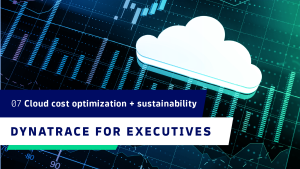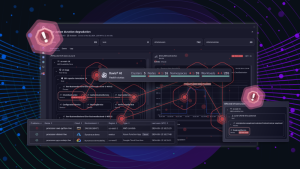The sense-think-act model of automation has come to define the capabilities of industrial robots and self-driving cars. But as IT teams increasingly design and manage cloud-native technologies, the tasks IT pros need to accomplish are equally variable and complex. AIOps and observability—or artificial intelligence as applied to IT operations tasks, such as cloud monitoring—work together to automatically identify and respond to issues with cloud-native applications and infrastructure.
In multicloud environments, IT teams often struggle to take timely action given a deluge of data and alerts for issues ranging from system performance, security risks, and application problems. As a result, teams often can’t identify or prioritize cyber threats or performance issues before applications lag or succumb to cyberattacks. Those application issues can translate into severe financial losses and business harm because of compromised data or abandoned customer loyalty.
Indeed, according to Dynatrace data, 61% of IT leaders say observability blind spots in multicloud environments are a greater risk to digital transformation as teams lack an easy way to monitor their infrastructure end to end. But applying the sense-think-act model for IT using AIOps and observability can make the difference.
The sense-think-act model for AIOps and observability
The sense-think-act model takes shape in the real world with self-driving cars and robots of all kinds. By sensing, thinking, and acting, these technologies can complete tasks automatically. The framework forms the basis of the SAE (Society of Automotive Engineers) automation levels 1 through 5 for cars.
This same sense-think-act model is also a useful framework for evolving IT operations practices. Accordingly, a software intelligence platform with sense-think-act capabilities enables self-driving IT operations and DevSecOps in the enterprise.
‘Sense’ with observability
Observability technology is how modern IT teams “sense” what is going on with user experience, application performance, and infrastructure health. Teams sense by collecting—and connecting—the massive data volumes these systems generate in the form of metrics, events, logs, traces, and user experience data.
Modern observability solutions such as Dynatrace observe an application’s complete transactional behavior, from user experience and application performance to infrastructure health, and everything in between. This includes automatically discovering all cloud services, mapping all application and infrastructure dependencies, and continuously learning from them. This is similar to a self-driving car that constantly updates its knowledge of the environment based on the incoming information from cameras, radar, and other sensors.
‘Think’ with artificial intelligence
Cumbersome legacy IT architecture is giving way to modern multicloud architectures where technologies, data, and processes converge to enable innovation. However, the resulting multicloud functionality and flexibility also bring complexity and scale that surpass human capacity to analyze and visualize.
This is where artificial intelligence (AI) comes in. AI in modern software intelligence solutions helps teams analyze volumes of observability data to distill precise answers and actionable insights. This automatic system analysis provides continuous intelligence to IT operations, DevOps, and site reliability engineering (SRE) teams.
‘Act’ with AIOps
The goal of any sense-think-act model is the action. Modern AIOps, or artificial intelligence for IT operations, combines full-stack monitoring with an AI engine that yields precise and continuous data intelligence. The system then turns these insights into automatable actions in real time.
Because AIOps generates precise answers from massive data using AI, it can trigger automation that improves system health and performance. For every task, teams need to ask, “Is this job better executed by a human or automatically using AIOps?” According to Gartner, by 2024, 30% of business leaders will rely on AIOps platforms. The automated insights they generate drive business-related decisions and trigger automatic actions.
An automatic and intelligent AIOps solution accurately pinpoints the root causes of anomalies and provides answers for how to fix them. By creating a thorough mapping of how a problem evolves in real time, such an AIOps solution provides automatic root-cause analysis, eliminating the need for manual investigation.
Self-driving operations at enterprise scale
Modern enterprises have ramped up large-scale projects surrounding application modernization, digital transformation, and cloud migration. Not surprisingly, the projects’ supporting architectures are already complex and become totally unmanageable if teams work with disconnected, manual solutions. There are just too many dynamic scenarios that are constantly changing.
So, what should IT operations and DevOps teams do? Like a self-driving car, modern teams need self-driving operations delivered through a software intelligence platform. A platform that provides a reliable sense-think-act experience can solve myriad use cases. As a result, applying AIOps to observability data can generate precise answers and actionable intelligence. Once constructed, teams can proactively orchestrate problem remediation using full automation or with a “human in the loop”. And all this needs to happen in a way that scales limitlessly to meet the needs of the modern enterprise.
How Dynatrace delivers a sense-think-act model using AIOps and observability
Sense-think-act is best known for self-driving cars and robots. But for organizations adopting cloud-native technologies, the model provides a blueprint for an automated response to IT complexity. AIOps and observability provide the mechanism for detecting, analyzing, and automatically responding to IT anomalies that threaten performance and uptime.
Using deterministic, fault-tree AI, Dynatrace provides end-to-end observability of multicloud environments, delivering precise answers for automated responses. With broad technology support, Dynatrace enables teams to unify even the most complex and dynamic multicloud workloads with out-of-the-box capabilities.
Dynatrace AI is always on, processing billions of dependencies to detect anomalies, deliver precise answers, and automate operations that enable self-healing.
To learn more about how to engage a sense-think-act model using AIOps and observability, read the ebook, “Developing an AIOps strategy for cloud observability.”





Looking for answers?
Start a new discussion or ask for help in our Q&A forum.
Go to forum